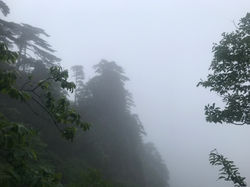【鹿港走讀】Lukang Kinmen Hall|金門館
已更新:2022年9月24日
吉客鏈:金門移民 X 鹿港通商 X 泉州文化
Prologue
Kinmen Island is as an outlying island of Taiwan, from which you can easily see mainland China. It has been a frontier defense location since the Ming Dynasty. I know it as a navy and army military base and also a fishery hub. I first visited Kinmen in 2012.
Kinmen is also an authentic Minnan-style 【Note1】island and a national park (recognized in 1995) with historical, natural and critical military features.
(Photo Credit | Chi Hsu, 2012.04 in Kinmen, Some military heritage spots.)
In fact, Kinmen has a long history than those mentioned above. This travelogue discuss some of its past glory.
See Kinmen in Lukang
Recently, I attended a Lukang walking tour and the first stop was Lukang Kinmen Hall. That's what made me remember earlier trip to the Island.

(Photo Credit | Chi Hsu, 2021.05 in Lukang - Kinmen Hall - 金門館)
Lukang, in the very west of Taiwan Island, was the major sea port in the 18-19th century. A merchants' township where many wealthy families established their first business. Why was a Kinmen Hall built in Lukang? and why was it preserved so well.
Geographical Location
Look at the map below. When Taiwan was ruled by the Qing Dynasty, Kinmen, with the shortest distance accessibility, started trading with Lukang and so created its prosperity.

(Source: Google)
Importantly, the majority of Lukang's settlers came from Quanzhou (Zayton), which as you know, was the Marco Polo's final destination in China in 1291 【Note2】.
Kinmen's Longer History
Quanzhou was the busiest international harbour in China between the 11th century and the 14th century. During the Tang Dynasty (A.D. 803), Kinmen was one of 5 horse pastures under Quanzhou's adminstration. During Yuan Dynasty (the 14th C.), Kinmen became one of the salt manufacturing centers through to Qing Dynasty (the 19th C.).
If I had lived in the early Kinmen, I'd have felt less secure during Ming - Qing dynasties when the Island became a frontier defense point. People tried to emmigrate overseas, and that's probably what I would have done. Over time there were a certain amount of overseas Kinmeneses into different locations in South East Asia.
The emmigrantion to overseas was doable as the nearby local ruler were usually from one of the navigator countries in Europe. However, most rulers were not friendly to the Chinese settlers after a while. So they kept some savings, then sent money back or returned to build a nice house in their hometown.
(Photo Credit | Chi Hsu, 2012.04 in Kinmen)
In general, Kinmen has the features of the hometown of overseas wealthy Kinmenese, the military defense base and Minnan culture.
Overseas's Kinmen Hall
To protect the Kinmen's immigration, in early Taiwan, the settlers built three Kinmen Halls to enshrine Kinmen people and Fu Jian's navy assigned by the defender. Lukang has a hall built in 1805 as a temple to enshrine Sufu Wangye(蘇府王爺).
The hall functioned as a guild hall for Kinmeneses and the naval soldiers assembly together. In 1848, an earthquake in Changhua damaged the building. The building was then rebuilt in Quanzhou style in 1855 with funds and builders assisted from the navy across Taiwan. Nowadays, the hall is recognised as a heritage site.
Lukang's Kinmen Hall is preserved very well but probably less people to know about it. When our walking tour group visited there, the Hall was very quiet.
(Photo Credit | Chi Hsu)
Somehow I enjoyed the quietness at the religion place. I looked up and appreciated its Quanzhou style's architecture and the mural paintings representing the "Four Employments" (四聘) in the main hall. In the ancient China, there were 4 best-known stories with regards to the emperor listening the outstanding advisor.
While people came here to worship Sufu Wangye, they also appreciated the ancient emperors as well as memorised the four advisors how did they contribute their wisdom and loyalty to the ruler.

(Photo Credit | Chi Hsu)
When I walked out I saw the calligraphy of "Pray the people to cross the Strait to Lukang".
After all discussions, I realize that Kinmen is the small isle with the big adventure spirit. I wish to go back there again for another holiday. Kinmen played a big role in modern Taiwan, and I'd tell that story in another travelogue.
【Note1】(Source: Wiki) Minnan culture or Hokkien/Hoklo culture, is considered as the Mainstream Southern Min Culture, refers to the culture of the Hoklo people, a group of Han Chinese people who have historically been the dominant demographic in the province of Fu Jian (called "Hokkien" in the Hoklo language) in Southern China, Taiwan, Singapore, and certain overseas Chinese communities in Southeast Asia.
The Introduction of Fujian Province below:
(Video Source: CCTV 紀錄)
【Note2】Marco Polo described "Zayton is very large and splendid. In this city is the port where all the ships from India arrive laden with costly wares, including precious stones of great value and big pearls of fine quality." (The Travels, p.222, by Marco Polo)

(Map Source: The Travels, Marco Polo)






























Comentarios